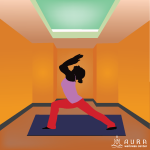As a yoga teacher, I encourage students to practice yoga at home all the time. Most students admit they don’t feel as motivated at home as in class. I’m not encouraging my students to stop coming to my classes, but an extra day of personal meditation, pranayama, and practicing asanas makes a big difference over the course of a week. Yoga teachers practice daily, so why not encourage our students to enjoy all the benefits we do?
Practice Yoga at Home
The attraction of being able to practice yoga, or any other form of fitness, at home is high. After all, taking a yoga class at a gym takes up a lot of extra time. The typical gym member spends 20 minutes driving to and from the gym, 10 minutes changing, and an additional 10 to 20 minutes if showering is needed before returning to work. Compare that with practicing yoga at home; there is no drive time to waste, and changing and showering can be even quicker than at the gym because everything is already in the shower stall or closet and there is no packing involved.
Reasons still abound which make the gym or yoga class a more attractive option. Yoga instructor feedback to help practitioners stay safe is one of the main advantages of doing yoga in a class under the supervision of a knowledgeable and experienced teacher. On the other hand, a few simple preparations and investments can make yoga practice at home a safe and positive experience.
Prepare for Yoga Practice
One of the most important things to consider in at-home yoga is having a safe place to practice in. Prepare the area by clearing a space on a carpet or hardwood floor, which is free of furniture, toys, laundry, or other potential safety hazards. Hardwood floor or linoleum is an option to carpet because it makes it easier for you to you keep proper alignment during balancing yoga poses. If you don’t have this option in your home, products like LifeBoard can provide a hard flooring substitute for carpet. Some practitioners love carpet because it challenges you in balancing postures.
Get Yoga Equipment
A few important investments in the right yoga equipment will go a long way to keeping you safe. Products important in practicing yoga safely include a sticky mat, often referred to as a yoga mat, and support items like bolsters, a yoga blanket and blocks.
Yoga blankets serve a dual purpose. They can be rolled up to provide support or lift during a pose, or they can be folded to provide additional cushioning. Bolsters and blocks allow users to prop up their bodies in certain poses to ensure proper posture and support.
Gain Yoga Knowledge
The most important characteristic in practicing yoga at home safely is knowing what you are doing. Make sure you do not attempt poses beyond your level of skill and strength. Attending yoga classes or using a DVD or online tutorial can provide you with the necessary instruction and background information for practicing yoga safely. No amount of preparation can help prevent injury if you move through poses too quickly or incorrectly, so checking in with knowledgeable yogis can also benefit your at-home yoga practice.
© Copyright – Aura Wellness Center – Publications Division
See our testimonials to find out what our graduates have to say about our selection of distance learning yoga teacher certification programs.
If you are teaching a yoga class, a yoga school manager, blogger, e-zine, or website publisher, and are in need of quality content, please feel free to use my blog entries (articles). Please be sure to reprint each article, as is. Namaste!
Related Posts:
The Benefits of Yoga Practice in Relation to Stress
Teaching Hatha Yoga – Explaining the Hidden Benefits of Yoga Practice


Leave A Comment
You must be logged in to post a comment.